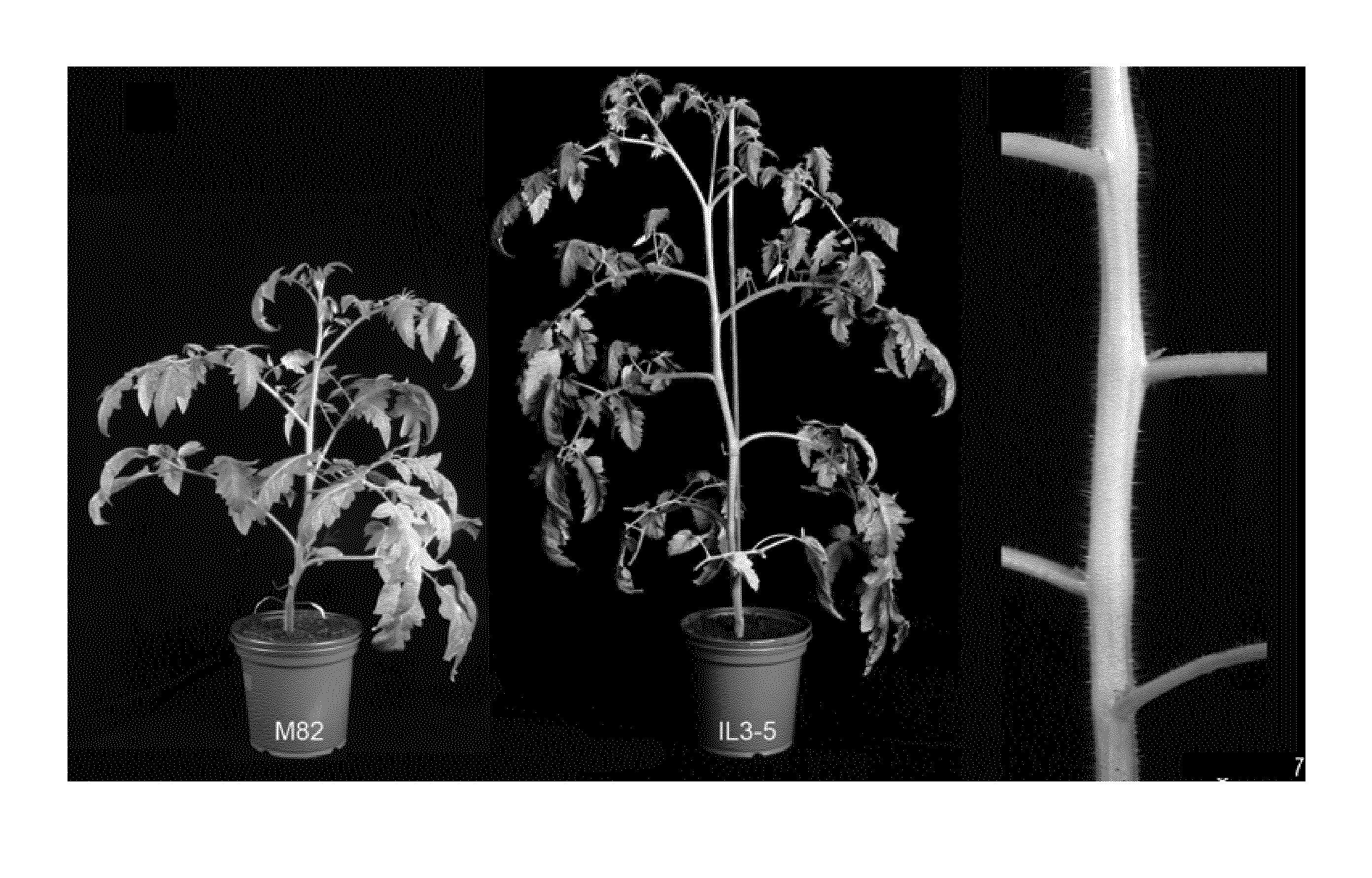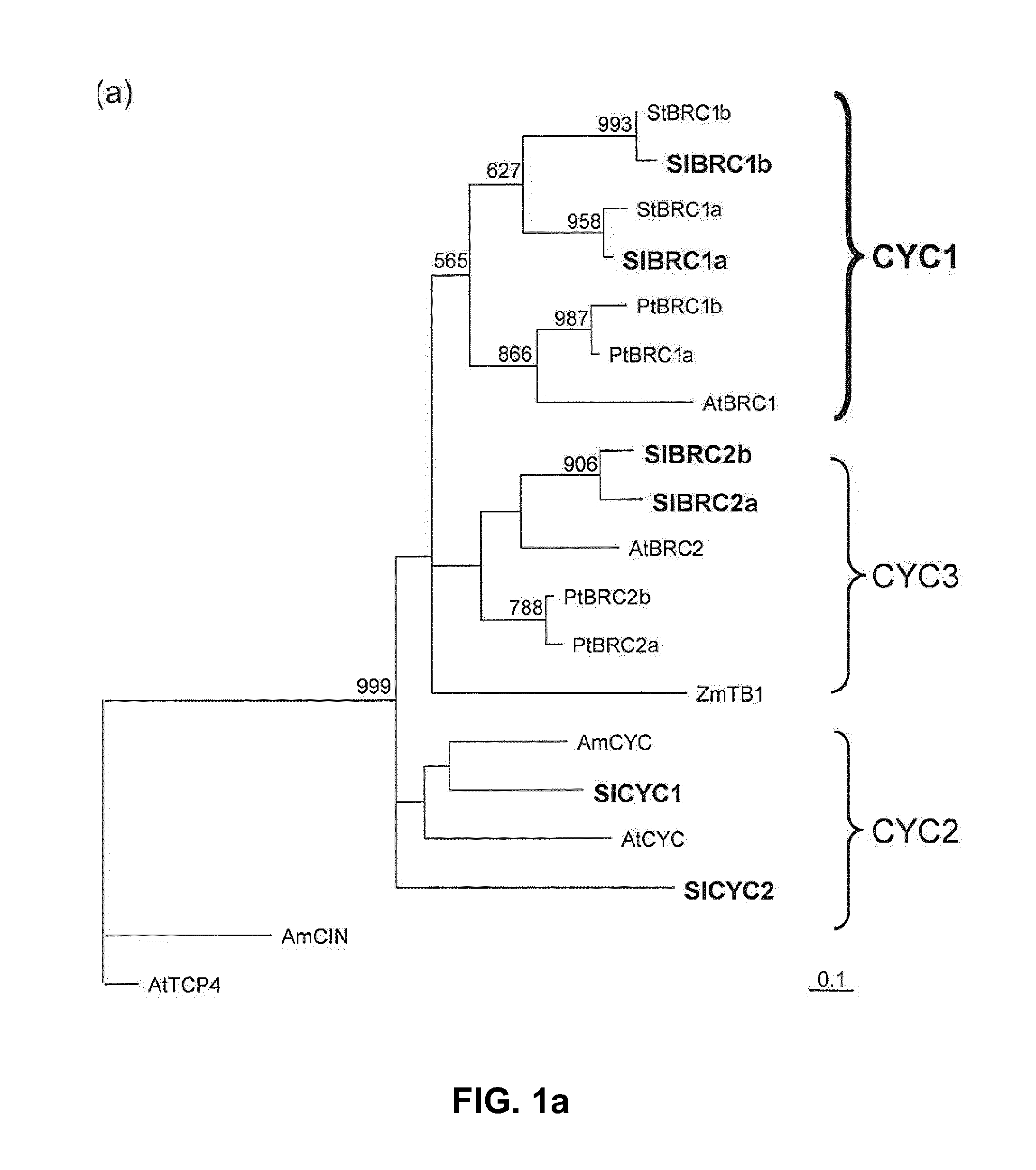Spbranched1a of Solanum Pennellii and Tomato Plants with Reduced Branching Comprising this Heterologous Spbranched1a Gene
a technology of spbranched1a and solanum pennellii, which is applied in the direction of plant/algae/fungi/lichens ingredients, peptide sources, peptide sources, etc., can solve the problems of molecular mechanisms underlying, the relationship between gene evolution and emergence of morphological novelties is still not well understood, etc., to improve the mechanical harvesting of tomatoes, avoid the deviation of assimilation, and facilitate pruning
- Summary
- Abstract
- Description
- Claims
- Application Information
AI Technical Summary
Benefits of technology
Problems solved by technology
Method used
Image
Examples
example 1
Identification of Tomato BRC1-Like Genes
[0095]The inventors searched for CYC / TB1 type genes in tomato genomic and EST databases (Mueller 2009. The Plant Genome, 2: 78-92) and identified six TCP genes of this group. Phylogenetic analyses showed that two were CYCLOIDEA (CYC)-like genes, two were BRC2-like genes and another two were BRC1-like genes. These six TCP genes were named SICYC1, SICYC2, SIBRC2a, SIBRC2b, SIBRC1a and SIBRC1b (Solanum lycopersicum CYC, BRC2, BRC1) respectively (FIG. 1a) and were mapped to tomato chromosomes 2-6 (FIG. 2). CYC-like genes have been shown to be expressed in floral meristems and to be mainly involved in the control of flower shape in many species. Inventors focussed on the two BRC1-like genes (SIBRC1a and SIBRC1b) and investigated their roles during tomato lateral shoot development.
[0096]Inventors first studied the transcriptional activity of these genes. For SIBRC1a, inventors isolated two cDNAs generated by alternative splicing: a short one, with a...
example 2
SpBRC1a Acts as a Suppressor of Shoot Branching in Tomato Role of SIBRC1a and SIBRC1b
[0099]The finding of two tomato BRC1-like paralogs more closely-related to each other than with AtBRC1, suggests that a duplication of BRC1 took place after the separation of the Brassicaceae and Solanaceae. These two BRC1-like genes map to different chromosomes, suggesting that they did not originate by segmental duplication but rather by chromosomal duplication or during the whole-genome duplication (WGD) occurred in Solanaceae 60-70 mya. Duplication, a common event in the evolution of genomes, is usually followed by loss of one of the gene copies by accumulation of deleterious mutations. In Arabidopsis, for instance, a single BRC1 gene has been found, although this species has undergone several WGD suggesting that all the other BRC1-like gene copies have been lost. A large number of models have been proposed to explain fixation, maintenance and evolution of duplicate genes.
[0100]These results ind...
example 3
SpBRC1a is the Responsible for the Strong Apical Dominance of Introgression Line IL3-5 Plants and Also of SpBRC1a Solanum lycopersicum Transgenic Plants
[0109]To confirm that SpBRC1a, contained in the introgression line IL3-5, is the gene responsible for the strong apical dominance of these lines, inventors caused silencing of SpBRC1a by generating RNAi transgenic lines carrying a sequence that is identical to part of its coding sequence. Inventors compared the branching phenotype of transgenic plants with those of M82 and with those carrying an empty binary vector. SpBRC1a was the responsible for the branch suppression RNAi lines having a similar number of branches as M82 plants.
3.1. SpBRC1a and the Strong Apical Dominance of Introgression Line 1L3-5 Plants.
[0110]3.1.1. CaMV35S:RNAi Constructs
[0111]A BRC1a-specific PCR product (225 bp) was cloned into the vector pHANNIBAL (CSIRO) using restriction sites BamHI / Clal and Xhol / Kpnl for the first and second cloning, respectively. Primers...
PUM
| Property | Measurement | Unit |
|---|---|---|
| length | aaaaa | aaaaa |
| amino acidic sequence | aaaaa | aaaaa |
| morphologies | aaaaa | aaaaa |
Abstract
Description
Claims
Application Information
 Login to View More
Login to View More - R&D
- Intellectual Property
- Life Sciences
- Materials
- Tech Scout
- Unparalleled Data Quality
- Higher Quality Content
- 60% Fewer Hallucinations
Browse by: Latest US Patents, China's latest patents, Technical Efficacy Thesaurus, Application Domain, Technology Topic, Popular Technical Reports.
© 2025 PatSnap. All rights reserved.Legal|Privacy policy|Modern Slavery Act Transparency Statement|Sitemap|About US| Contact US: help@patsnap.com



